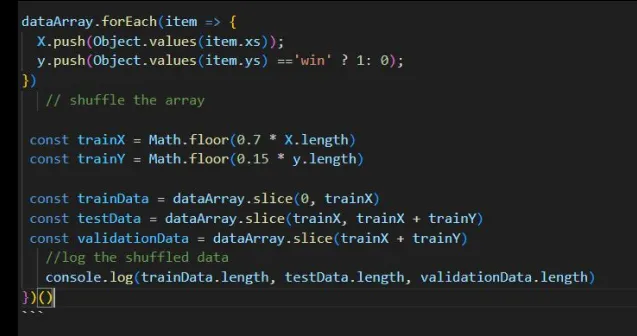
Why Split a Dataset into Training, Validation, and Test Sets?
Learn the purpose of dividing datasets into training, validation, and test sets, and see practical examples of how to implement this in TensorFlow.js for better machine learning models.
· tutorials · 2 minutes
The Purpose of Dataset Splits in Machine Learning
Splitting a dataset into training, validation, and test sets is a fundamental step in machine learning. Each subset serves a unique purpose in the development, optimization, and evaluation of a model.
Why Split the Dataset?
-
Training Set: This subset is used to train the model. It helps the model learn patterns and relationships in the data.
-
Validation Set: Used during training to tune hyperparameters and prevent overfitting. It helps monitor the model’s performance on unseen data during training.
-
Test Set: Held back until the final evaluation phase to assess the model’s performance. It provides an unbiased evaluation of how the model will perform on real-world data.
Without these splits, you risk overfitting the model to the data or failing to get a realistic estimate of its generalization ability.
Example: Dataset Splitting in TensorFlow.js
Here’s how to split a dataset into training, validation, and test sets using TensorFlow.js:
1. Import TensorFlow.js
import * as tf from '@tensorflow/tfjs';2. Define the Dataset
Assume we have a simple dataset of numerical values:
const data = [ { features: [1, 2], label: 0 }, { features: [3, 4], label: 1 }, { features: [5, 6], label: 0 }, { features: [7, 8], label: 1 }, { features: [9, 10], label: 0 }, { features: [11, 12], label: 1 },];3. Shuffle and Split the Dataset
We’ll shuffle the data to ensure randomness and split it into 70% training, 15% validation, and 15% test sets:
// Shuffle the dataconst shuffledData = tf.util.shuffle(data);
// Split the dataconst trainSize = Math.floor(0.7 * data.length);const valSize = Math.floor(0.15 * data.length);
const trainingSet = shuffledData.slice(0, trainSize);const validationSet = shuffledData.slice(trainSize, trainSize + valSize);const testSet = shuffledData.slice(trainSize + valSize);4. Prepare the Data for TensorFlow.js
Convert the datasets into tensors:
const toTensors = (dataset) => { const features = dataset.map((item) => item.features); const labels = dataset.map((item) => item.label);
return { features: tf.tensor2d(features), labels: tf.tensor1d(labels, 'int32'), };};
const trainTensors = toTensors(trainingSet);const valTensors = toTensors(validationSet);const testTensors = toTensors(testSet);Why Is Splitting Important?
- Training Set: The model learns patterns in the data.
- Validation Set: Monitors the model’s ability to generalize to unseen data during training.
- Test Set: Provides a final measure of how well the model performs on completely unseen data.
EXAMPLE
const tf = require("@tensorflow/tfjs-node");const path = require("path");const fs = require("fs");
const cspath = path.join(__dirname, 'drive/MyDrive/Colab Notebooks/data.csv');
const dataset = tf.data.csv(`file://${cspath}`, { columnConfigs: { lastCandleRange: {}, secondLastCandleRange: {}, entrytolow: {}, outcomeBinary: { isLabel: true } }, configuredColumnsOnly: true});
(async ()=> {
const dataArray = await dataset.toArray() const shuffle = tf.util.shuffle(dataArray)
const X = [] const y = []
dataArray.forEach(item => { X.push(Object.values(item.xs)); y.push(Object.values(item.ys) =='win' ? 1: 0);}) // shuffle the array
const trainX = Math.floor(0.7 * X.length) const trainY = Math.floor(0.15 * y.length)
const trainData = dataArray.slice(0, trainX) const testData = dataArray.slice(trainX, trainX + trainY) const validationData = dataArray.slice(trainX + trainY) //log the shuffled data console.log(trainData.length, testData.length, validationData.length)})()More posts
-

Implementing Recurrent Neural Networks (RNNs) in TensorFlow.js Using Tabular Data
Learn how to implement Recurrent Neural Networks (RNNs) in TensorFlow.js using tabular data. This guide walks you through preprocessing, building an RNN architecture, training, and evaluation for sequential data tasks.
-

Element-Wise Multiplication of Tensors in TensorFlow.js
Learn how to perform element-wise multiplication of two tensors in TensorFlow.js with a clear example. A simple and practical guide for beginners.
-

Constant Tensor vs Variable Tensor in TensorFlow.js
Understand the difference between constant and variable tensors in TensorFlow.js, and how to use each effectively. Simple explanation with examples.